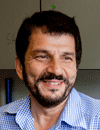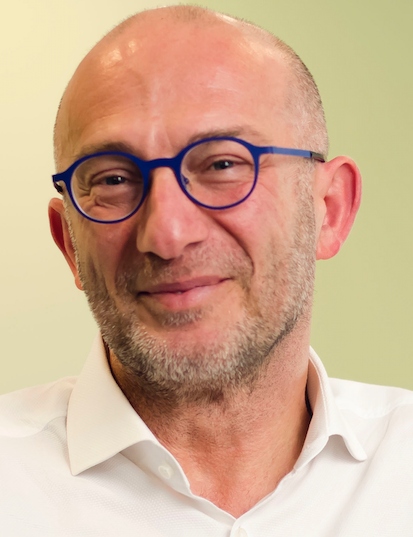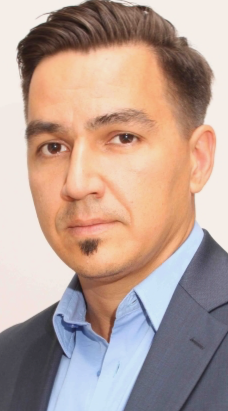Monday, 17 August 202008:00 | Conference Registration, Materials Pick-Up, Morning Coffee and Pastries | |
Session Title: Conference Plenary Session -- Innovations in Microfluidics, 3D-Bioprinting and BioFab 2020 |
| | 09:30 |  | Keynote Presentation Drop-based Microfluidics For Single-Cell Analysis
David Weitz, Mallinckrodt Professor of Physics and Applied Physics, Director of the Materials Research Science and Engineering Center, Harvard University, United States of America
This talk will describe the use of microfluidic technology to control
and manipulate drops whose volume is about one picoliter. These can
serve as reaction vessels for biological assays. These drops can be
manipulated with very high precision using an inert carrier oil to
control the fluidics, ensuring the samples never contact the walls of
the fluidic channels. Small quantities of other reagents can be
injected with a high degree of control. The drops can also encapsulate
cells, enabling cell-based assays to be carried out. The use of these
devices for cell analysis will be described. |
| 10:00 |  | Keynote Presentation Emergent Engineering of Human Neurological Disease Models
Roger Kamm, Cecil and Ida Green Distinguished Professor of Biological and Mechanical Engineering, Massachusetts Institute of Technology (MIT), United States of America
Microphysiological models have now been developed for a variety of
single organs, as well as multi-organ systems. These models are also
beginning to find useful applications in the pharmaceutical and biotech
industry as disease models and for intermediate throughput drug
screening. The current models range from those that are generated by
precisely seeding in a device populations of fully differentiated or
primary cells that then assemble into functional monolayers or simple 3D
structures on one extreme, to ones that are fully emergent, forming by
self-assembly often within a single cluster of pluripotent cells on the
other. We refer to these two approaches as ‘top-down engineering’ and
‘emergent engineering’. In this presentation, the full range of
techniques will be discussed, with examples derived from applications in
the context of neurological function and disease. |
| 10:30 | Morning Coffee Break and Networking in the Exhibit Hall | 11:30 |  | Keynote Presentation Engineering Printable 3D Vascularized Tissue Constructs
Shulamit Levenberg, Professor and Dean, Faculty of Biomedical Engineering, Technion Israel Institute of Technology, Israel
Living tissues require a vascular network to supply nutrients and gases and remove cellular waste. Fabricating vascularized constructs represents a key challenge in tissue engineering. Several methods have been proposed to create in vitro pre-vascularized tissues, including co-culturing of endothelial cells, support cells and cells specific to the tissue of interest. This approach supports formation of endothelial vessels and promotes endothelial and tissue-specific cell interactions. In addition, we have shown that in vitro pre-vascularization of engineered tissue can promote its survival and perfusion upon implantation. Implanted vascular networks, can anastomose with host vasculature and form functional blood vessels in vivo. Sufficient vascularization in engineered tissues can be achieved through coordinated application of improved biomaterial systems with proper cell types. We have shown that vessel network maturity levels and morphology are highly regulated by matrix composition. We also explored the effect of mechanical forces on vessels organization and analyzed the vasculogenic dynamics within the constructs. We demonstrated that morphogenesis of 3D vascular networks is highly regulated by tensile forces. Creating complex vascular networks with varying vessel sizes is the next challenge in engineering vascularized tissue constructs. 3D bioprinting, the controlled and automatized deposition of biomaterials and cells, represents a very attractive approach to solve this issue. This technique allows for combining different bioinks (biocompatible printable materials) in an organized fashion to attain native-tissue mimicking structures.
|
| 12:00 |  | Keynote Presentation “More is More”: Precision Microfluidics of Large Volumes
Mehmet Toner, Helen Andrus Benedict Professor of Biomedical Engineering, Massachusetts General Hospital (MGH), Harvard Medical School, and Harvard-MIT Division of Health Sciences and Technology, United States of America
Microfluidics gained prominence with the application of microelectromechanical systems (MEMS) to biology in an attempt to benefit from the miniaturization of devices for handling of minute samples of fluids under precisely controlled conditions. Microfluidics exploits the differences between micro- and macro-scale flows, for example, the absence of turbulence, electro-osmotic flow, surface and interfacial effects, capillary forces in order to develop scaled-down biochemical analytical processes. The field also takes advantage of MEMS and silicon micromachining by integrating micro-sensors, micro-valves, and micro-pumps as well as physical, electrical, and optical detection schemes into microfluidics to develop the so-called “micro-total analysis systems (µTAS)” or “lab-on-a-chip” devices. However, the ability to process ‘real world-sized’ volumes efficiently has been a major challenge since the beginning of the field of microfluidics. This begs the question whether it is possible to take advantage of microfluidic precision without the limitation on throughput required for large-volume processing? The challenge is further compounded by the fact that physiological fluids are non-Newtonian, heterogeneous, and contain viscoelastic living cells that continuously responds to the smallest changes in their microenvironment. Our efforts towards moving the field of microfluidics to process large-volumes of fluids was counterintuitive and not anticipated by the conventional wisdom at the inception of the field. We metaphorically called this “hooking garden hose to microfluidic chips.” We are motivated by a broad range of applications enabled by precise manipulation of extremely large-volumes of complex fluids, especially those containing living cells or bioparticles. This presentation will provide a summary of our efforts in bringing microfluidics to large volumes and complex fluids as well as various applications such as the isolation of extremely rare circulating tumor cells from whole blood. The use of high-throughput microfluidics to process large-volumes of complex fluids (e.g., whole blood, bone marrow, bronchoalveolar fluid) has found broad interest in both academia and industry due to its broad range of utility in medical applications. |
| 12:30 |  | Keynote Presentation Interferometric Detection: From Multiplexed Label-free Affinity Measurements to Counting Single Biomolecules
M. Selim Ünlü, Distinguished Professor of Engineering, Department of Electrical and Computer Engineering, Boston University, United States of America
Interferometric reflectance imaging sensor (IRIS) technology is based on interference of light from an optically transparent thin film—the same phenomenon that gives rainbow colors to a soap film when illuminated by white light. IRIS has two modalities: (i) low-magnification (ensemble biomolecular mass measurements) allowing for multiplexed affinity measurements and (ii) high-magnification (digital detection of individual nanoparticles) along with their applications, including label-free detection of multiplexed protein chips, measurement of single nucleotide polymorphism, quantification of transcription factor DNA binding, and high sensitivity digital sensing and characterization of nanoparticles and viruses.
In vitro tests are a cornerstone of clinical practice, with the sensitivity of standard immunoassays measuring protein biomarkers at picomolar concentrations. This level of sensitivity is sufficient for the diagnosis of infectious diseases when clear symptoms are present, however it falls short significantly for the detection of molecular biomarkers that are important in cancer, neurological disorders, and the early stages of infection as well as environmental sensing. Perhaps one of the most exciting recent technological developments in biomarker analysis is single-molecule counting or digital detection, an approach that provides resolution and sensitivity beyond the reach of ensemble measurements. In this presentation, we will cover the technical developments of IRIS platform as well as our efforts in technology commercialization. |
| 13:00 | Networking Lunch in the Exhibit Hall, Exhibits and Poster Viewing | |
Session Title: Emerging Themes in 3D-Bioprinting, circa 2020 |
| | 15:00 |  Bioprinting Technologies for Regenerative Medicine and Disease Modeling Bioprinting Technologies for Regenerative Medicine and Disease Modeling
Patrick Thayer, Bioprinting Solutions Architect, CELLINK
Discussion of different bioprinting techniques, such as extrusion- and light-based, and how they can be utilized to create tissue models for regenerative medicine, drug testing, disease modeling, and other applications.
| 16:00 | Biomaterial Free 3D Cardiac Tissue Creation
Narutoshi Hibino, Associate Professor, University of Chicago, United States of America
| 17:00 |  | Keynote Presentation Extracellular Matrix Alloys For Vascular Tissue Engineering
Joyce Wong, Professor of Biomedical Engineering and Materials Science & Engineering, Boston University, United States of America
To engineer and build tissues, one requires an understanding of key relationships between cell behavior and the underlying substrate. In native tissues, extracellular matrix proteins are in the form of fibrous networks, sheets, and fibers. Over the past few years, we have been investigating the role of composition and processing conditions of various extracellular matrix fibers and alloy fibers on mechanical properties and biological properties. These fibers are also critical components of tissues such as blood vessels. We have also determined the role of mechanical strain on binding of different antibodies and peptide-functionalized contrast agents to these fibers. Importantly, we discovered that composition can be tuned to stabilize extracellular matrix proteins in fiber forms, which is especially useful with compositions where it is difficult to process the proteins into fibers. Through an integrated computational and experimental approach, we have discovered relationships between hydrophobicity and protein fiber forming capability and stability. Moreover, we have verified that the protein alloy fibers support cell adhesion and allow one to tune the mechanical properties of the fiber. This is of significance as the mechanical properties of the substrate play an important role in modulating cell behavior, e.g. cell migration and proliferation. |
| 17:30 | Close of Day 1 of the Conference |
Tuesday, 18 August 202008:00 | Morning Coffee, Tea and Pastries in the Exhibit Hall | |
Session Title: Challenges and Opportunities in the 3D-Bioprinting Field |
| | 08:30 | Engineering Cryogel Scaffolds to Reconstruct Aspects of the Tumor Microenvironment
Sidi Bencherif, Assistant Professor, Department of Chemical Engineering, Northeastern University, United States of America
Hypoxia, defined as low oxygen tension, is a characteristic feature of solid tumors and a hallmark of aggressive cancers. Metabolic adaptation to hypoxia leads to tumor cell growth and invasion, resistance to apoptosis, and multi-drug resistance. For decades, a number of solid tumor models have been engineered to emulate key aspects of tumor biology such as hypoxia. However, challenges with tumor formation and reproducibility, inadequate biomechanical cues and 3D microenvironmental features provided to cells, and uncontrolled oxygen depletion among other limitations led to non-physiological tumor cell responses and inaccurate clinical predictions to anti-cancer drugs. To model solid tumors more accurately, we have recently developed an innovative approach using macroporous cryogel scaffolds to induce rapid oxygen depletion while enabling cellular rearrangement into spherical-like cell aggregates within a 3D polymer network. Our preliminary data suggest that our engineered cryogel scaffolds are capable of inducing local hypoxia while promoting tumor cell remodeling and aggressiveness, leading to anti-cancer drug resistance. Tumor-laden cryogels may mimic key aspects of the native tumor microenvironment, making these advanced cellularized scaffolds a promising platform for drug screening and potentially advancing drug development and discovery. | 09:00 |  | Keynote Presentation High-Definition Bioprinting
Aleksandr Ovsianikov, Professor, Head of Research Group 3D Printing and Biofabrication, Technische Universität Wien (TU Wien), Austria
3D bioprinting and biofabrication are already providing disruptive solutions for tissue engineering and regenerative medicine (TERM). However, the most widespread technologies are based on computer-controlled deposition of cells or assembly of cellular units, and thus cannot achieve spatial resolution better than few tens of micrometres. Lithography-based methods approach the problem from a different direction, by producing 3D structures within cell-containing materials and can therefore overcome this limitation. Among these methods, multiphoton lithography (MPL) is an outstanding one as it can produce features even smaller than a single mammalian cell (down to around 100 nm). Our recent breakthroughs on the material development side enabled the use of MPL for direct fabrication of cell-containing constructs, giving rise to High-Definition Bioprinting. In this contribution the principles of HD Bioprinting, its recent progress of as well as its perspectives for further TERM applications, will be discussed. The presentation is supported by numerous examples. |
| 10:00 |  The Biologicalisation of Medicine and Manufacturing The Biologicalisation of Medicine and Manufacturing
William G Whitford, Life Science Strategic Solutions Leader, DPS Group
The biologicalization (or the biological transformation) of
manufacturing is essentially the use of digital manufacturing approaches
(Industry 4.0) with biological and bio-inspired principles to support
more efficient and sustainable manufacturing. It creates a biomimetic
design – from reactions, equipment, and assemblies to materials,
processes, and facilities. For example, Nobel Prize winner Frances H.
Arnold invented systems directing the evolution of enzymes now routinely
used in development catalysts in manufacturing. This approach to
biologicalisation of processes is dependent upon advances in
biochemistry, many of the ‘omics, as well as genetic engineering. From
another direction, advances in fermentation and cell-culture
technologies is supplying a cell-based biologicalisation of processes.
Harmonization of digital principals with bio-integrated systems supports
processes composed not only of biological chemistries, but of
engineered organoids, tissues and cells. As supported by
nano/micro-technology, cell-based systems can enable the goals of
sustainability, economy and efficiency in research and therapeutics.
| 10:30 | 3D Bioprinted Vascularized Glioblastoma Model
Guohao Dai, Associate Professor, Department of Bioengineering, Northeastern University, United States of America
Glioblastoma (GBM), the most malignant brain cancer, remains deadly despite wide-margin surgical resection and concurrent chemo- & radiation therapies. Two pathological hallmarks of GBM are diffusive invasion along brain vasculature, and presence of therapy-resistant tumor initiating stem cells. Deconstructing the underlying mechanisms of GBM-vascular interaction may add a new therapeutic direction to curtail GBM progression. However, the lack of proper 3D models that recapitulate GBM hallmarks restricts investigating cell-cell/cell-molecular interactions in tumor microenvironments. In this study, we created GBM-vascular niche models through 3D bioprinting containing patient-derived glioma stem cells (GSCs), human brain microvascular endothelial cells (hBMVECs) cells, pericytes, astrocytes and various hydrogels to model glioma/endothelial cell-cell interactions in 3D. In summary we have created GBM-vascular niche models that can recapitulate various GBM characteristics such as cancer stemness, tumor type-specific invasion patterns, and drug responses with therapeutic resistance. Our models have a great potential in investigating patient-specific tumor behaviors under chemo-/radio-therapy conditions and consequentially helping to tailor personalized treatment strategy. The model platform is capable of modifying multiples variables including ECMs, cell types, vascular structures, and dynamic culture condition. Thus, it can be adapted to other biological systems and serve as a valuable tool for generating customized tumor microenvironments. | 11:45 | Origami Microfluidics for Biomimetic Liver on a Chip
Carol Livermore, Associate Professor, Department of Mechanical and Industrial Engineering, Northeastern University, United States of America
Fluid mechanics at the shortest length scales enable many functions of life, including the human body’s microcirculation. Ideally, we would be able to translate the body’s fluid mechanics directly into engineered tissues and organ on a chip systems, but conventional microfluidics still lag behind much of what our bodies can do. A good example is the liver; conventional organs on a chip can struggle to replicate the liver’s massively parallel flow and perfusion architecture. Origami-based microfluidics offer a new paradigm for addressing these challenges. Folding offers a low-cost, rapid means of creating flow structures that mimic vasculature. Multi-material architectures enable additional transport via diffusion, and directed assembly of cells can offer hierarchical structure at the smallest length scales. This talk will present the enabling tools of origami tissue engineering, including the use of folding to create multi-material, flow/perfusion microfluidic devices as a platform for scalable tissue engineering. In particular, the presentation will focus on the design, fabrication, and characterization of liver tissue units made via this multi-functional, multi-material approach. | 12:45 | Lunch | 13:30 | Advanced Biomanufacturing of Functional Tissues
Andrew Lee, Director of 3D Bioprinting, FluidForm Inc., United States of America
Significant efforts to engineer tissues with controlled composition and architecture has resulted in the development of a wide range of specialized bioprinting processes that have produced impressive results. The challenge for implementing these bioprinting processes is in finding effective and efficient paths toward fulfilling new and wide-ranging applications as well as in developing robust, clinically-relevant solutions. Here, we introduce Freeform Reversible Embedding of Suspended Hydrogels (FRESH) as a versatile 3D bioprinting platform that can serve as a tissue fabrication sandbox for researchers and clinicians. We will discuss the design and fabrication of functional components of the heart to demonstrate the ability of FRESH to assemble soft native materials in complex geometries. We will then extend these capabilities toward discussing the potential applications of FRESH as a core technology in tissue engineering and beyond. | 14:30 | Next-Generation Bioprinting For Manufacturing Tissue-Engineered Products
Fabien Guillemot, Chief Executive Officer, Poietis, France
Main challenges for the manufacturing of tissue engineered advanced therapy medicinal products (ATMPs) relate to the standardisation of manufacturing processes and the improvement of tissue functionality, and cost-effectiveness and profitability of related treatments. Producing advanced therapy medicinal products remains a cumbersome process with costs, reproducibility and scalability issues.
Poietis develops biomanufacturing solutions based on Next Generation Bioprinting (NGB). This new platform integrates automation and robotics technologies, and is coupled with numerous online sensors – including cell microscopy – and Artificial Intelligence processing. In addition, it integrates all bioprinting techniques (laser-assisted bioprinting, bioextrusion, micro-valve bioprinting), a world’s first in the bioprinting market.
Based on our experience on bioprinting full-thickness skin equivalents, we will discuss how next-gen bioprinting technology – should make it possible to overcome current tissue manufacturing bottlenecks and also provide new therapeutic opportunities. | 16:00 | Additive Manufacturing of 3D Bone Tissue Model
Jungwoo Lee, Assistant Professor, University of Massachusetts-Amherst, United States of America
Creating functional bone tissue analogs outside of the body represents a unique opportunity to understand bone biology better. Various biomaterials and engineering strategies have been developed, but a realistic bone tissue model that reproduces both surface and subsurface cellular and extracellular matrix complexity remain unsuccessful. Mature bone consists of multiple lamellar bones interfaced with osteocytes that are primary mechanosensory cells. In this presentation, I will introduce a new approach to create bone tissue replica by additive manufacturing of the lamellar structure of bone. We first developed a process to generate a thin section of demineralized compact bone that supports the aligned adhesion of osteoblasts and structural mineral deposition. We then exploited tissue-engineering strategies to induce osteoblast-to-osteocyte differentiation via stacking multiple layers of osteoblasts pre-seeded demineralized bone paper and subsequently applying cyclic mechanical compression under hypoxic milieu. Our additive manufacturing of bone tissue demonstrated precise control of the thickness and both surface and subsurface cellular complexity. We envision that the presented additive manufacturing bone tissue models is expected to greatly advance bioengineering trabecular bone for basic and applied researches. | 16:30 | Tissue Engineering Approaches to Model Breast Cancer Metastasis
John Hundley Slater, Associate Professor of Biomedical Engineering, University of Delaware, United States of America
Metastasis is a leading cause of cancer-associated mortality with a 5-year survival rate of only 26% for metastatic breast cancer patients in the US. Despite recent advances in the detection, diagnosis, and treatment of primary tumors, treatment of metastases remains challenging. While animal models closely recapitulate the physiological environment, they are often difficult to implement to track cellular events occurring during metastasis with high spatial and temporal resolution and provide relatively low throughput for therapeutic discovery. Accordingly, there is an urgent need for in vitro devices that accurately recapitulate cellular events occurring during the metastatic cascade that could act as higher throughput platforms for therapeutic development. Toward this goal we have developed fluidized, tissue engineered constructs that allow for monitoring of cellular events during metastatic progression over long term culture. We developed hydrogel formulations that provide direct control over breast cancer cell fate with respect to aggressive growth and dormancy. We implemented 16 hydrogel formulations that systematically vary adhesivity and crosslinking density and have identified formulations that induce different phenotypes in the MDA-MB-231 triple negative breast cancer line. Certain hydrogels induce aggressive growth characterized by high proliferation, high metabolic activity, increased cell density, low apoptosis, and the formation of invasive cell clusters. Other formulations induce cellular dormancy characterized by low proliferation, low metabolic activity, no change in cell density, low apoptosis, and the cells residing as rounded solitary cells that show no invasive characteristics and do not form clusters. Other hydrogel formulations induce tumor mass dormancy characterized by a near perfect balance between proliferation and apoptosis where cell density remains constant over time. Cells residing in either dormant state display increased resistance to common chemotherapeutics compared to those undergoing aggressive growth. We also demonstrate the ability to reactivate cells undergoing dormancy to an active growth state through a dynamic increase in hydrogel adhesivity. After this dynamic switch, these once metabolically dormant cells become activated and begin forming invasive cell clusters similar to metastatic relapse. Additional efforts to model the metastatic cascade include the fabrication of vascularized tissue constructs to monitor extravasation during metastasis and investigating the roles of inflammation in mediating extravasation efficiency. In summary, the ability to model crucial cellular events during metastasis using tissue engineered constructs may provide crucial insights for the development of new therapeutic strategies to prevent or eliminate metastatic cancer. | 17:30 | Close of Day 2 of the Conference |
|
